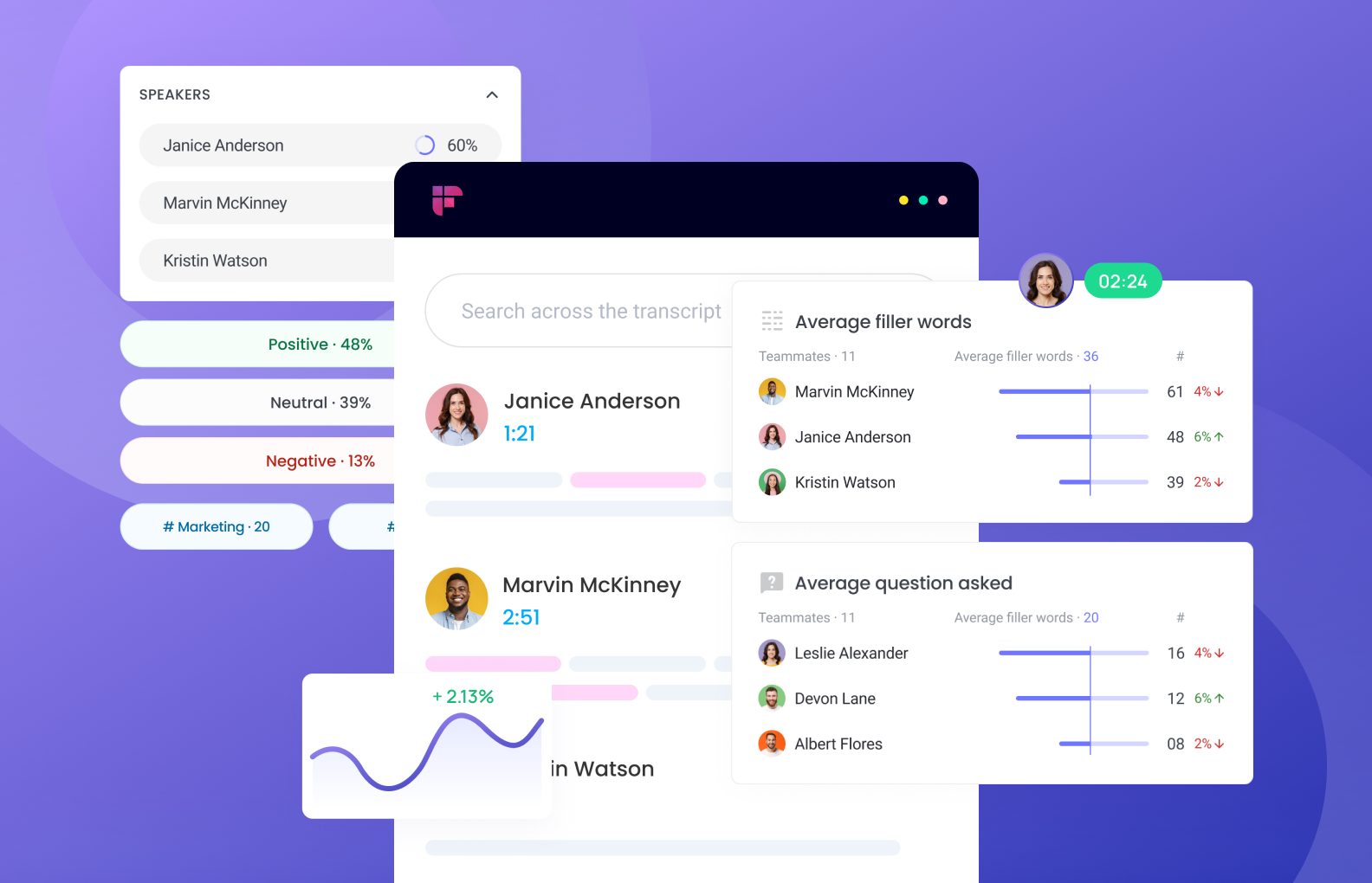For decades, businesses have relied on a proven technique to improve employee development and performance—360-degree feedback.
360-degree feedback provides a comprehensive view of a sales team's strengths and weaknesses. By gathering input from multiple sources, you can gain a well-rounded perspective of a team's performance so you can make informed decisions about maximizing their potential.
In this blog, we’ll explore the benefits of 360-degree feedback for sales teams and provide you with best practices for implementing this powerful tool in your organization.

What is 360-degree feedback?
360-degree feedback, or multi-rater feedback, is a widely accepted method involving gathering anonymous feedback from several sources within a business. This feedback is typically provided by:
- Managers
- Peers
- Direct reports
- Customers
By collecting feedback from multiple perspectives, 360-degree feedback provides a complete picture of performance. However, managers primarily use 360-degree feedback as a development tool rather than a performance evaluation tool.
Collected knowledge can help an employee, team, or entire organization recognize their shortcomings and strengths, allowing them to pinpoint areas for growth.
Try Fireflies for free!
Even though 360-degree feedback can negatively impact individuals, as feedback can be biased, incomplete, or misleading, many companies have successfully implemented it to drive growth and development within their teams.
How does 360-degree feedback work?

The following steps outline the key elements of a 360-degree feedback process and how it can provide valuable insights for a team or individual employee development and organizational success.
- Identify the sources: Identify the individuals who will provide feedback, such as an employee's manager, peers, subordinates, and customers.
- Gather feedback: Administer a survey or questionnaire to the identified sources, asking about a team's or employee's performance, competencies, and behavior. Managers should design the questions to measure specific skills or behaviors.
- Ensure anonymity: Gather feedback anonymously to encourage honesty and minimize bias.
- Compile the feedback: After gathering it, compile it into a report with numerical ratings and written comments from various sources.
- Provide feedback: Provide the report to your sales team or employee, allowing them to review the feedback and identify areas for improvement.
- Develop a plan: Work with a coach or mentor to interpret the feedback and develop an improvement plan.
- Implement the plan: Take action to address any concerns or issues identified in the feedback report.
- Monitor progress: Regularly monitor and adjust the plan to ensure continued growth and development.

360-degree feedback examples

Curious to see what 360-feedback looks like? This hypothetical scenario demonstrates the process.
At Acme Innovations, John, a senior sales executive, receives 360-degree feedback from his manager, peers, and customers.
The feedback report shows John is highly skilled in building relationships with established clients but needs to manage sales leads and develop his negotiation skills.
Using the feedback, John attends sales training sessions on lead generation and negotiation techniques and works with his coach to develop a plan to improve his skills. As a result, John can generate more leads and negotiate better deals, leading to increased sales revenue and higher client satisfaction ratings.
John's example highlights how you can customize a 360-degree feedback program to an individual's needs and lead to significant improvements. This customization is one of the many ways organizations can leverage 360 feedback to enhance their teams and achieve better results.
Here are some specific 360-degree feedback examples that show how a sales team can improve:
- Increase engagement and conversion rates by adopting best practices for email deliverability.
- Improve communication and collaboration skills among team members, leading to more effective sales strategies and higher customer satisfaction.
- Increase leadership and management effectiveness, resulting in better coaching, goal-setting, and alignment of sales team efforts.
- Enhance performance and productivity of sales team members, as well as improve decision-making and problem-solving abilities.
- More innovative and creative approaches to sales strategies and tactics, leading to new revenue streams and increased market share.
What are the benefits of 360-degree feedback?

360-degree feedback offers numerous benefits for employees and organizations. Here are a few of them:
1. Improved self-awareness and development
360-degree feedback gives employees a comprehensive view of their strengths and weaknesses, allowing them to understand better their performance and how to improve. You can then use this input to develop tailored individual development plans that align with a company's goals and mission.
2. Increased accountability
Traditional feedback typically trickles down only from above. But with 360 feedback, employees are held accountable for their behaviors and performance from all directions. This increased accountability can improve performance and create a stronger sense of ownership at work.
3. Fair and objective performance evaluation
360-degree feedback provides a more equitable and accurate assessment of an employee's performance by gathering input from multiple sources, reducing the potential for bias or favoritism.
4. Improved communication and collaboration
Gathering feedback from various sources can help identify communication breakdowns and areas for improved collaboration between teams or departments. This varied feedback can lead to more effective teamwork and higher productivity.
Additionally, by using 360-degree feedback, organizations can gather valuable data on employee performance, which can inform the development of a data-driven sales strategy that leads to greater success.
What are the potential risks of 360-degree feedback?

While 360-degree feedback can offer numerous benefits, there are also potential risks and disadvantages. Here are a few of the key concerns to keep in mind.
Negative feedback can be demotivating
Negative feedback from multiple sources can demotivate employees, especially if they feel overwhelmed or attacked, and decrease job satisfaction and performance if not handled properly.
Risk of inaccurate feedback
Because 360-degree feedback relies on information from various sources, you can receive inaccurate feedback if you do not choose sources carefully or base input on unreasonable criteria. Inaccuracies can lead to incorrect evaluations and negative consequences for the team or employee.
Time-consuming and resource-intensive
Collecting input from various sources can require time, money, and effort. Some companies may need more staffing to complete 360 feedback without other operations suffering.
Lack of trust and confidentiality
Anonymity in 360-degree feedback is essential but can also lead to a lack of trust and faith in the process. Some employees may believe management will use their input against them somehow.
5 Best practices to implement 360-degree feedback

Implementing 360-degree feedback can be a powerful tool for developing a successful sales team, but it's important to do it right. Here are five best practices for implementing an effective 360-degree feedback program:
1. Define clear goals and expectations
Before launching a 360-degree feedback program, clearly define the goals you want to achieve and communicate these expectations to all involved parties. Here are some steps to follow:
- Define the purpose of the feedback
- Determine who will receive it
- Decide how you will collect the feedback
- Establish what actions will be taken based on the results
Setting clear goals and expectations ensures that all participants are on the same page and that feedback correlates with a company's objectives.
2. Ensure confidentiality and anonymity
Ensuring the feedback process is confidential and anonymous is crucial to encourage honest and open feedback. Third-party technology or independent consultants can help smaller organizations accomplish this.
3. Train raters and participants
Proper training ensures that all participants understand the feedback process and give helpful, valuable feedback. Managers should provide training for employees receiving feedback and those providing it. Raters and participants must understand the goal of the input, the criteria being reviewed, and how to offer constructive and courteous feedback.
4. Use a mix of quantitative and qualitative data
A successful 360-degree feedback program should incorporate quantitative and qualitative data, including ratings, comments, and specific examples of behavior. A combination of quantitative and qualitative data gives a complete understanding of an employee's performance and aids in identifying particular improvement opportunities.
5. Follow up and take action
After feedback collection, following up with participants and acting on the comments received is critical. This follow-through shows the feedback is valued and can lead to meaningful change and growth.

It is essential to present participants with a summary of the feedback received and to work with them to formulate an improvement action plan.
Elevate your sales strategy with 360-degree feedback
Understanding what 360-degree feedback is and how it can benefit your sales team is crucial for creating a culture that enables continuous improvement and growth.
Implementing 360 feedback requires careful planning and execution. However, with the best practices outlined above, you can reap the benefits of 360 feedback while minimizing potential drawbacks.
Get started with 360-degree feedback today to see the impact on your team's performance.








